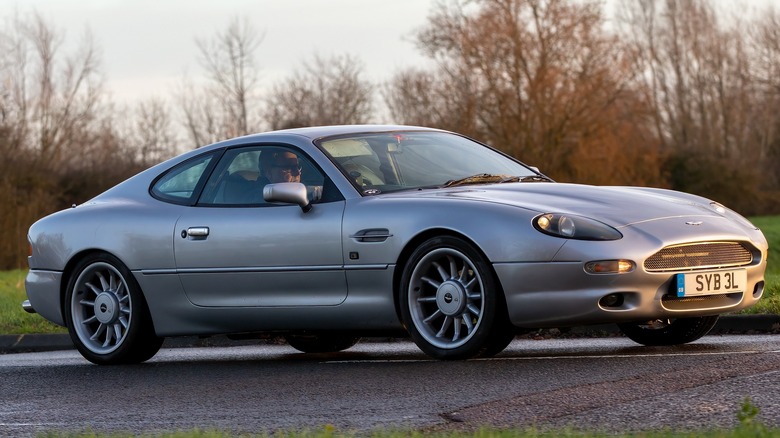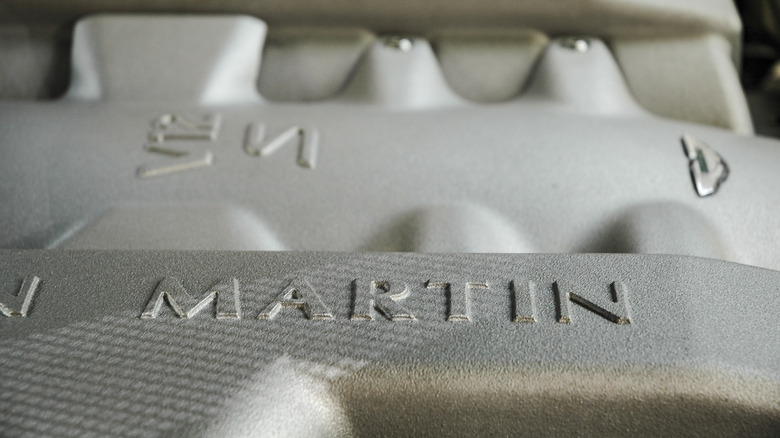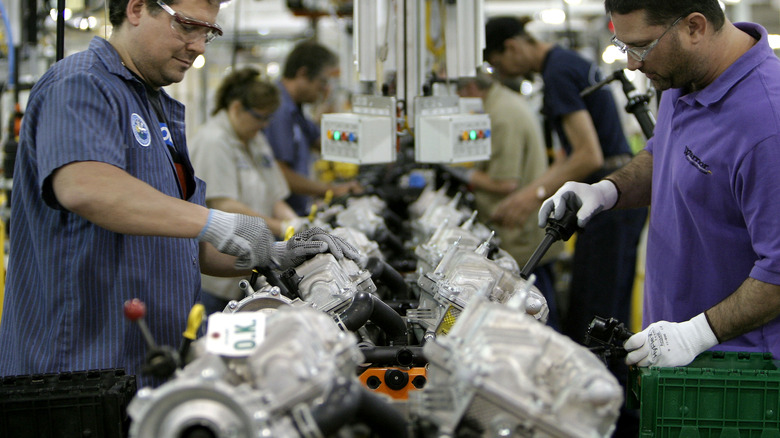The Aston Martin V12 Engine Myth You Shouldn't Believe
If you're a fan of Aston Martin, you'll remember the V12 that powered the company's most prominent vehicles through the late '90s and early 2000s. The iconic 450 horsepower motor was used in the DB7, DB9, DBS, Vanquish, and a host of race-winning touring cars. However, despite its success, the AM V12 is also the source of some nasty rumors. There is a long-standing myth that Aston's V12 is essentially just a pair of Ford's very good — but not supercar-level — Duratec V6s that have been laid end to end and bolted together.
On the face of it, the rumor has a lot of plausibility. Ford actually owned Aston Martin between 1991 and 2007. While this era saw Aston Martin produce some of its most iconic vehicles, take center stage in Bond movies, and court success on race tracks, it also saw a lot of standard Ford parts making it into high-end cars. There was also a Mondeo that looked suspiciously like the DB9 that actually did have a Duratec V6 under the hood along with a Ford Fusion (released as a Mondeo in the UK) a little later that borrowed heavily from Aston Martin's style.
Then there's the level of performance Aston Martin offered at the time, which adds yet more credibility to the suggestion. While current Astons are pushing things to the limit under the hood, older models weighed heavily on their looks. Casting aside any rose-tinted spectacles, 0 to 60 times on a DB7 were around six seconds, and the DB9 managed to get it just under five. This was, and still is, fast, but it was noticeably slower than similarly priced supercars of the era.
It's a funny joke, but simply untrue
Despite steering wheels, grills, and various other Ford components making it into several turn-of-the-millennium Astons, a pair of hastily combined Ford V6 engines certainly did not. The powerful V12 Aston Martin relied on a brand new, specially cast engine block with specialist cylinder heads along with purpose-built internals like the camshafts and crankshaft. Even some of the materials used, such as the aluminum the heads were cast from, were of a higher grade than Ford used on the Duratec V6.
The AM V12 was a high-performance engine designed to go under the hood of Aston Martins. There are things high-performance engines go through that regular motors just aren't capable of. For example, Aston's V12 has around 200 more horsepower than the Duratec V6, though admittedly the six extra cylinders really help there. In addition, the combustion chambers had a notably higher compression ratio than the Duratec's, as well as tumble port intakes.
With that being said, there was certainly plenty of design inspiration provided by the Duratec, and some components did actually make it across. So while it's very unfair to insinuate that the AM V12 is what you get when you cross a team of lazy designers with a pair of Ford V6s and a bucket of epoxy — there are still some solid links that must be acknowledged.
It does contain a lot of Ford Duratec engine parts
While Martin's Cosworth RA V12 isn't the product of a couple of Ford V-12s and a welding set, it does share a lot of internals with its 3-liter brethren. So, while it isn't fair to say Aston simply shoved two pre-built Ford engines next to each other, you do have to acknowledge that the two engines do have a lot in common.
Cosworth worked with Ford to develop a good number of the engine's internal components, including the pistons, valves, rocker arms, rods, and cam profiles used in the Duratech V6. To further complicate matters, the Duratech V6 isn't purely a Ford engine. In fact, its early design phase involved a lot of input from legendary German sports car manufacturer Porsche. Ford then added some finishing touches before modified versions of it ended up in the likes of the Jaguar S-Type, Mazda CX-9, and, of course, the Ford Mondeo — the good but slightly boring sedan that was used to give the rumor that bit of extra impact.
So while both engines are closely related, it's like comparing a very hard worker who's done quite well in life with his professional athlete cousin. They both share a lot of DNA — and may even have the same nose — but they're two completely different people and should both be appreciated for what they are.


